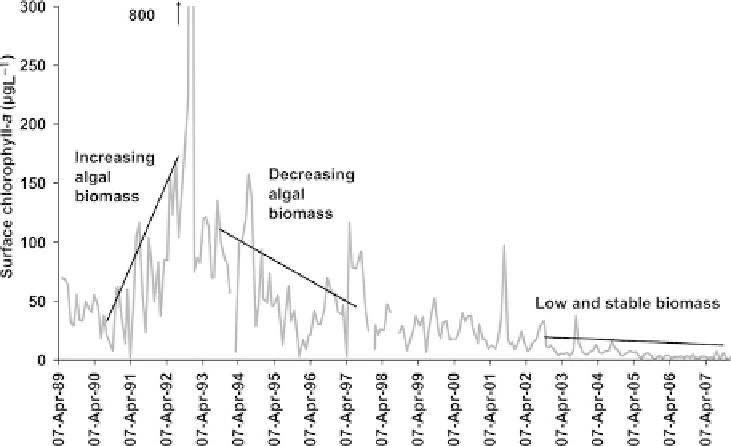Environmental Engineering Reference
In-Depth Information
Figure 14.5.
Chlorophyll-a concentrations in Salford Quays (Basin 7) between
1989 and 2007.
that the action of the Helixors would directly limit the growth of algae by
intermittently circulating the cells into the aphotic zone at the lower depths
(Radway et al.
1988
; Horne & Goldman
1994
). However Bellinger et al.(
1993
)
suggested that the cells do not spend long enough in the aphotic zone to
greatly reduce photosynthesis in the Quays. In the absence of nutrient add-
itions to the enclosed waters, it was suggested that internal recycling initially
played an important role in sustaining the algal blooms (Bellinger et al.
1993
).
Over the longer term, nutrients gradually became fixed in the oxygenated
sediments and were, therefore, unavailable for algal growth. A linear regres-
sion equation on logged data from Basin 9 illustrated a significant correlation
(p
<
0.01) between Oscillatoria densities and total phosphorus concentrations
over time (1989 2007). Whilst 'top-down' control mechanisms on algal biomass
are commonly the most important in shallow lakes (Moss et al.
1994
), other
studies have found that 'bottom-up' control via alterations to nutrient avail-
ability and physical factors (e.g., mixing) can be most influential in deep water-
bodies (McQueen
1990
; Williams & Moss
2003
).
Phytoplankton dynamics since isolation over time are mirrored closely by
chlorophyll-a concentrations, as would be expected (
Fig. 14.5
). Stepwise mul-
tiple regression revealed that Oscillatoria agardii, and to a lesser extent the blue-
green Anabaena circinalis, were the most significant contributors to algal bio-
mass, the former having a correlation coefficient with chlorophyll-a of 0.610
(p
0.001) (Hendry
1991
). Chlorophyll-a concentration peaked at 800
m
gL
1
in
<

